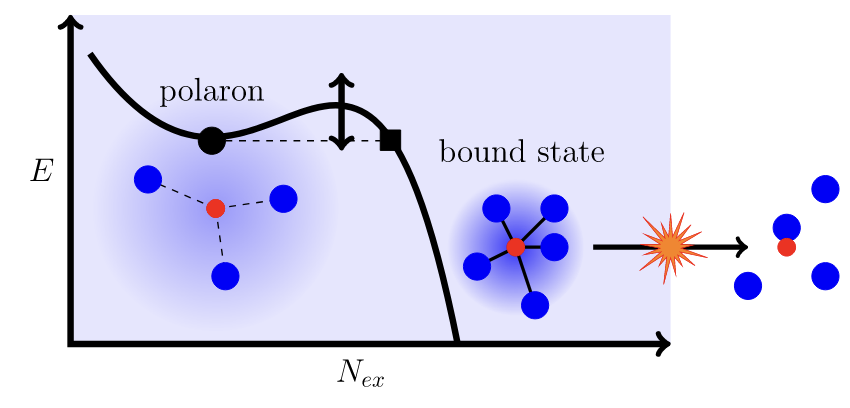It is well known in chemistry that the medium in which a chemical reaction happens, can have a profound effect on the outcome of the reaction. But what happens if the medium is quantum?
One of the most “quantum” media one can imagine is a Bose Einstein condensate (BEC) of cold atoms, where all particles in the system are in the same quantum state and thus behave collectively. If we then introduce an impurity (an atom of a different type), said condensate deforms itself around this impurity, forming a polaron quasiparticle with modified properties!
An impurity can scatter off the bosons forming the BEC. If the impurity is scattered with just one boson, the scattering is elastic: the only thing which can happen is a phase shift. And this is kind of boring, isn’t it?
However, when not two, but three atoms collide, suddenly collisions can lead to chemical reactions! We, Arthur, Richard and Ignacio, therefore raised the following question: how do these chemical reactions affect the quasiparticle, and vice versa, how does the excitation cloud modify the reaction? These are the questions that the paper answers.
Before understanding the answer to this question, we need to dive a bit in to three-body physics. Classically, it is well known that any potential which has a well can trap a particle: thus there is always a bound state. However, in quantum mechanics, one may have a so-called zero-point energy. This means that sometimes the potential is too shallow to fit a bound state. Or in other words, that the zero-point energy is too large to form a bound state. What can now happen in quantum mechanics, is that for two atoms no bound state fits in their interaction potential, but that when you add a third, it suddenly fits! This is called the Efimov effect.
In fact, this also extends to more particles: the more particles one adds, the easier it is to make a bound state. It is as if the atoms help each other to form a bound state! In the paper, we call this cooperative binding (we borrowed this term from chemistry, as is the case for oxygen with hemoglobin). However, these clusters of cold atoms are not very stable: the formation of such clusters lead to rapid chemical reactions! So at any point where a cluster comes to exist, this chemical reaction occurs very rapidly.
What we show is that the particles in the polaron cloud forming around the impurity, can participate in the formation of these clusters, and therefore stimulate the chemical reactions! In fact, as soon as any cluster can be formed and as long as it survives, the impurity attracts more and more particles from the BEC, leading to an instability of the polaron even without the reactions! Altogether this is a remarkable example of chemistry in a quantum medium.
Our results pave the way for further studies of the bipolaron problem where medium-induced polaron-polaron interactions become crucial. We provide new insight into the role three-body correlations play in many-body systems such as quenched BEC.
Joint PRL/PRA publication: Chemistry in a quantum medium
- Arthur Christianen, J Ignacio Cirac, Richard Schmidt, Chemistry of a light impurity in a Bose-Einstein condensate, [Phys. Rev. Lett. 128, 183401] (2022)
- Arthur Christianen, J Ignacio Cirac, Richard Schmidt, Bose polaron and the Efimov effect: A Gaussian-state approach, [Phys. Rev. A 105, 053302] (2022)


Comments are closed